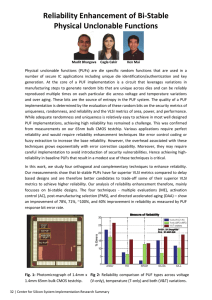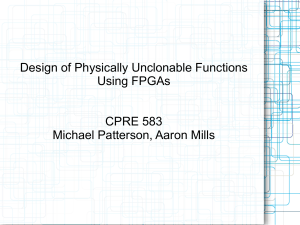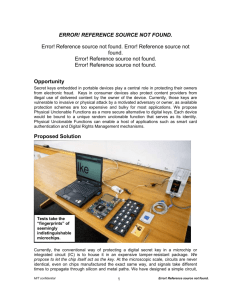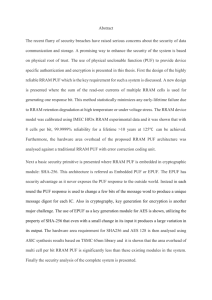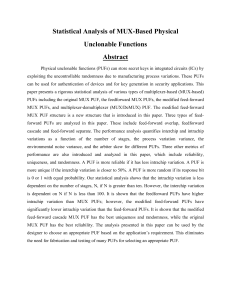Recombination of Physical Unclonable Functions Please share
advertisement
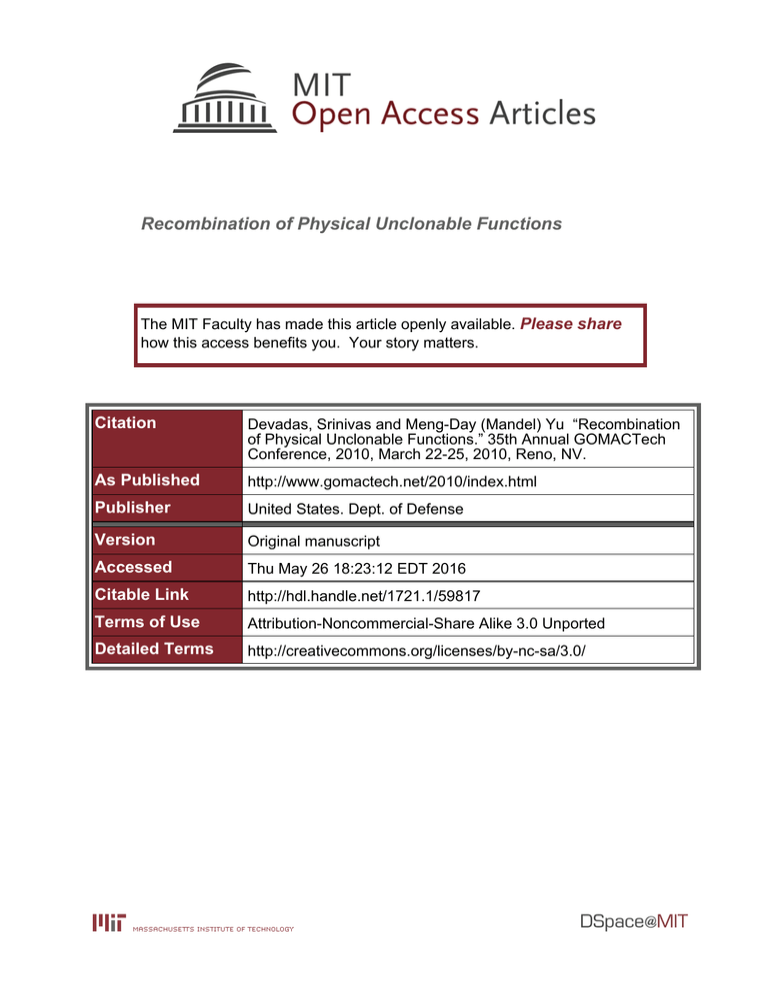
Recombination of Physical Unclonable Functions
The MIT Faculty has made this article openly available. Please share
how this access benefits you. Your story matters.
Citation
Devadas, Srinivas and Meng-Day (Mandel) Yu “Recombination
of Physical Unclonable Functions.” 35th Annual GOMACTech
Conference, 2010, March 22-25, 2010, Reno, NV.
As Published
http://www.gomactech.net/2010/index.html
Publisher
United States. Dept. of Defense
Version
Original manuscript
Accessed
Thu May 26 18:23:12 EDT 2016
Citable Link
http://hdl.handle.net/1721.1/59817
Terms of Use
Attribution-Noncommercial-Share Alike 3.0 Unported
Detailed Terms
http://creativecommons.org/licenses/by-nc-sa/3.0/
Recombination of Physical Unclonable Functions
Meng-Day (Mandel) Yu
myu@verayo.com
Verayo, Inc
San Jose, CA
Srinivas Devadas
devadas@mit.edu
MIT
Cambridge, MA
Abstract: A new Physical Unclonable Function (PUF)
construction is described, by treating silicon unique
features extracted from PUF circuits as “genetic material”
unique to each silicon, and recombining this chip-unique
material in a way to obtain a combination of advantages
not possible with the original PUF circuits, including
altering PUF output statistics to better suit PUF-based key
generation and authentication.
have since been realized. An arbiter-based PUF, which
has a large challenge space (e.g., 264 bits or more) was
prototyped in an ASIC [3], and a variant was
commercialized in the form of an “unclonable” RFID IC
[4], opening the door for use of PUFs for authentication
with virtually unlimited challenge and response pairs. A
ring-oscillator PUF, was built and tested in [1]. Use of
initial SRAM state as a PUF was explored and tested in [5].
Keywords:
FPGA and ASIC authentication; key
generation; rights management; supply chain TRUST
Introduction to Recombination
Recombination builds on prior work in Physical
Unclonable Functions, and can be applied to various types
of silicon PUFs as well as other noisy pseudo-random
sources, including biometric sources. Recombination can
also be applied to a system containing different types of
PUFs or a system containing both PUF and biometric
sources. In genetic engineering, recombination refers to the
process where genetic material is rearranged and joined to
other genetic material. The resulting output may possess
genetic combinations or characteristics not previously
present.
In a similar way, chip-unique characteristics
extracted from a PUF circuit (or from different types of
PUF circuits and biometric sources) may be recombined to
produce characteristics not natively present in the original
circuit, e.g., outputs with different statistical characteristics,
with bias removed. This is achieved by treating siliconunique features extracted by PUF circuit as “genetic
material” that is then recombined, subject to an input
stimulus (i.e., challenge), as shown in Figure 1.
Introduction
Over the past decade, the concept of net-enabled operations
has become a cornerstone of our national defense strategy.
An issue of growing concern is the possibility of cyber
attacks that allow an adversary to obtain sensitive
information or possibly take either partial or full control of
remotely operated systems.
Silicon-based Physical
Unclonable Functions (PUFs) serve as a critical design
primitive to secure these microelectronics systems [1].
This paper describes a new PUF construction by treating
silicon unique features extracted from PUF circuits as
“genetic material” unique to each silicon device, and
recombining this chip-unique material in a way to obtain
advantages not present with the original PUF circuits.
These advantages include:
•
De-biased PUF Outputs that pass NIST Statistical
Tests for Randomness, resulting in excellent raw
material for key generation and for authentication.
•
Enabling a Fully-Challengeable Real-Valued PUF,
supporting both 1) a large challenge space (e.g., 264
bits) suitable for authentication based on challenge /
response pairs; and 2) real-valued outputs suitable for
soft decision error correction, which increases
environmental stability and reduces implementation
complexity for key generation.
•
Realizable in both FPGAs and ASICs, reducing risks
of ASIC deployments via rapid FPGA prototyping and
emulation, and offering protection for FPGA as well as
ASIC-based devices and systems.
Introduction to Physical Unclonable Functions
The use of Physical Unclonable Functions (PUFs) as a
silicon-unique root of trust was first proposed by
researchers at MIT [2], enabling authentication based on
chip-unique responses as well as generation of chip-unique
cryptographic keys. Multiple silicon-based PUF circuits
Challenge
n
PUF Circuit
Recombination
Function
Chip-unique
“Genetic
Material”
w
Response
Figure 1: Using recombination to alter PUF
characteristics
For the purposes of this paper, the discussion shall be
focused on use of recombination on silicon-based PUFs,
and in particular, oscillator PUFs. Oscillator PUF in [1]
has an average 0th order (dc) bias value of 46.15%. By
using a simple recombination function that groups
oscillators into n stages, and ensuring that the output for
each stage si statistically results in a bias neutral output, the
sum of all stages S is then also statistically bias neutral.
n −1
•
S = ∑ si
i =0
An example of this simple construction uses
•
si = (ci * 2 – 1) x (f2i – f2i+1)
where
•
0 <= i < n, and
•
ci є {0,1}, is an instantaneous challenge bit that is a
result of a seed challenge processed by a mixer (e.g., a
linear feedback shift register with a primitive
polynomial or a hash function).
This is shown in Figure 2. S is a signed quantity.
Challenge
mixer
PUF Circuit
Recombination Function
1 -1
c0
RO
RO
f0
-
x s0
f1
1 -1
c1
RO
RO
f2
-
x
s1
+
S
Response
f3
1 -1
cn-1
RO
RO
f2n-2
-
x sn-1
f2n-1
Figure 2: Example of recombined oscillator PUF
More complex examples include use of Response to
perturb Challenge (output feedback) or affect subsequent
Response values (output feed forward), use of nested
recombination functions, use of recombination functions
that vary with prior Response values, or the use of XORs,
majority functions, or other logical or mathematical
functions.
As an example of output feed forward
recombination, values can be grouped in groups of 6, with
the first two bit values pointing to one of the four
subsequent values as the (final) Response value:
•
Response value = (S1,S0 == 0,0)? S2: (S1,S0 == 0,1)? S3:
(S1,S0 == 1,0)? S4: S5;
As a part of the design derivation process, various
recombination functions were first emulated in software,
with oscillator PUF data obtained in hardware from Xilinx
Virtex-4 LX25 devices. Table 1 shows randomness test
results by applying recombination to PUFs in four
representative LX25 devices, and analyzing 100 million
recombined PUF output bits per device.
The
recombination structure shown in Figure 2 was used, with a
64-bit challenge and 64 ring oscillator pairs. The 100
million bits for each device was derived from the same
starting 64-bit seed challenge that was loaded into an LFSR
to obtain subsequent challenges. Success rates for each of
the 15 NIST tests across the four chips were comparable
with success rates derived from a NIST-recommended set
of random numbers (last column). The results show that a
recombined oscillator PUF has a negligible dc bias, since a
dc bias of more than 51% or less than 49% would result in
low NIST test pass rates (e.g., in the single digit
percentages). The results contrast with the native dc bias of
46.15% found in oscillator PUF in [1], which readily fails
NIST Statistical testing. Recombination, by this measure,
produced better raw material for use in key generation and
authentication, producing a PUF bias that is negligible
based on NIST Statistical Testing, and is superior to the
46.15% bias found in an oscillator PUF in [1], 23% bias
found in an early version of an arbiter PUF in [3], and the
approximately 46% bias found in a memory PUF in [5].
Fully-Challengeable Real-Valued PUF
In addition to de-biasing PUF output, the recombined PUF
in Figure 2 is also a Fully-Challengeable Real-Valued PUF
supporting both of the following features:
•
a large challenge space (e.g., 264 bits), suitable for
authentication based on challenge / response pairs; and
•
real-valued outputs suitable for soft decision error
correction, to increase environmental stability and
reduce complexity for key generation. (The msb of S
in Figure 2 indicates a bit polarity of 1 or 0, and the
remaining bits of S indicate strength of that bit.)
It is difficult to produce both of these characteristics with
other PUF implementations described in existing open
literature. Arbiter PUFs (with multiple arbiters and output
processing) in [1, 3] for example, have a large challenge
space but natively do not produce real-valued outputs of
sufficient resolution (e.g., at least 4 bits), thus complicating
error correction. Neither the oscillator PUF realized in [1]
nor the memory PUF as described in [5] has a large
Table 1: NIST Statistical Tests for Randomness success ratio for recombined PUF output bits
Statistical Test
Frequency
BlockFrequency
CumulativeSums
Runs
LongestRun
Rank
FFT
NonOverlappingTemplate
Overlapping Template
Universal
ApproximateEntropy
RandomExcursions
RandomExcusionVariant
Serial
LinearComplexity
1
Block/Template
Length
Success ratio
(chip #100)
Success ratio
(chip #101)
Success ratio
(chip #102)
Success ratio
(chip #103)
Reference1
bitstream
128
9
9
10
16
500
99%
100%
99% - 99%
97%
100%
100%
100%
94% - 100%
98%
97%
100%
98%-100%
97% - 100%
99% - 99%
100%
99%
100%
99% - 100%
99%
100%
98%
100%
95% - 100%
98%
98%
99%
97% - 100%
97% - 100%
99% - 100%
99%
98%
99%
97% - 98%
100%
99%
100%
100%
95% - 100%
99%
100%
99%
97% - 100%
97% - 100%
99% - 100%
99%
99%
99%
99% - 99%
99%
99%
100%
100%
95% - 100%
98%
96%
99%
98% - 100%
96% - 100%
98% - 98%
99%
98%
97%
98% - 99%
100%
97%
100%
100%
95% - 100%
97%
100%
100%
98% - 100%
93% - 100%
98% - 100%
100%
100% (188/188) pass
99% (187/188) pass
100% (188/188) pass
99% (187/188) pass
100% (188/188) pass
99% (187/188) pass
100% (188/188) pass
99% (187/188) pass
100% (188/188) pass
98% (184/188) pass
Cumulative p-values
Cumulative proportions
From George Marsaglia’s Random Number CDROM.
Figure 3: Accelerated aging data, key generation. Provisioning at 25oC, 1.0V, regeneration at 145oC, 1.05V.
No errors for over 3 million regenerations. Worst case bit deviation for each time interval shown.
challenge space. When applied to the oscillator PUF,
recombination results in a PUF with a large challenge space
which was not present in the original oscillator PUF.
Note that model-building (e.g., using machine learning) to
build a software clone within reasonable time [3] may be
possible for PUFs using simple recombination functions. If
resistance against model-building attacks is required, a
more complex recombination function needs to be used.
To support key generation, the following components were
added to the recombined PUF of Figure 2:
•
Index-Based Syndrome Codec, supporting 0th to 5th
order indices;
•
1x, 3x, and 5x repetition coder and majority decoder;
and
•
BCH(63) codec supporting t = 1 to 6.
These building blocks are described in detail in [6]. Index
Based Syndrome Coding was used, taking advantage of
recombined real-valued outputs, to achieve a 16x to 64x
reduction in error correction code complexity through use
of soft decision coding [6].
Figure 3 shows environmental test results in a
representative device (Xilinx Virtex-5 LX50). Results show
that raw bit flips (pre-ECC) for error correction block size
of 63 do not deviate much for over 21 years of acceleratedlife operation; the least square fit curve has a negligible
slope of -.02. Test parameters for accelerated aging were
derived from MIL-STD-883G Method 1005.8 Steady State
Life as well as accelerated aging parameters obtained from
Xilinx. Specifically, .70eV activation energy was assumed,
at a confidence level of 60% (same assumptions as those
used by Xilinx). Over 3 million error correction blocks
were run, with no failures across 21 accelerated-life years,
implying error correction block failure rate below .34 ppm.
In-flux testing was done, with pre/post ECC output
gathered while both temperature and voltage stresses were
applied as a part of the accelerated life testing.
Provisioning was at 25oC, 1.0V, and regeneration at 145oC,
1.05V, and thereby illustrating stability in key generation
across a wide range of temperature and voltage conditions.
Data obtained is consistent with the error free performance
across millions of tests under mil-spec temperature and
extreme voltage conditions in [6].
Multi-mode PUF
The key generation design tested in the previous section is
actually a Multi-mode PUF design operating in key
generation mode. This design is multi-modal in that it can
operate in both C/R authentication mode (due to large
challenge space achieved using recombination) and in key
generation mode (recombined real-valued outputs results in
stable and efficient error correction). To provide flexible
multi-modal operation, this design supports multiple
oscillator banks and a variety of recombination functions,
including the one shown in Figure 2 as well as 2/4/8 way
XORs, multi-LFSR mixing, and other features. This design
was successfully implemented and tested in a variety of
devices, including Virtex-4 LX60 and Virtex-5 LX50.
certain classes of designs, using the Xilinx ICAP facility,
and this bitstream can be mixed with a challenge to
produce a response that is unique to the runtime bitstream
and unique to the FPGA device, as shown in Figure 5.
An illustrative use case for Multi-mode PUF is shown in
Figure 4, where PUF #1 is used in key generation mode
and PUF #2 is used in C/R authentication mode; this is to
provide a layered security approach that is stronger than
conventional approaches of using only burn-in keys. PUF
#1, by using different challenges, generates multiple root
seeds; this is costly with conventional approaches.
Conventional approaches also rely on security by physical
obscurity and are broken if design is physically de-layered
and visualized. A PUF is immune to such an attack, since
all devices have the same layout and yet produce different
keys. The device can be authenticated by an entity that
knows the root seed (or a key derived from root seed) by
sending a random nonce N as shown in the figure, which is
encrypted on the device and can be decrypted on the client
side. Optionally, a second multi-mode PUF operating in
C/R authentication mode (PUF #2) can be added. PUF #2
offers an extra measure of security by relying on C/R
authentication where C/R pairs are used only once and
discarded. The response of PUF #2 is encrypted using the
root seed or derived key and decrypted on the client side.
With FPGA and ASIC using the same recombined PUF
design, rapid FPGA prototyping and emulation can be used
to reduce ASIC tape-out risks. In addition, de-biasing via
recombination can increase yield and reduce risks when
PUF is ported across different ASIC process nodes.
MM-PUF #1
(Key Generation)
Root
Seed
Additional security by
switching Root Seed
MM-PUF #2
(C/R Authentication)
Crypto
Block
R
Encrypted and
Authenticated
Channel
N
Challenge space = 264
Figure 4: Using two Multi-mode PUFs to provide
layered security
Realization in both FPGAs and ASICs
Recombination can be used to create a PUF with large
challenge space (e.g., 264 bits) in FPGAs. This is a
capability that does not exist for FPGAs using other PUF
implementations realized to date as found in open
literature, including [1-5]. A memory PUF, for example,
would be compromised if an adversary reads initial value
of every memory location in the device; a dump of all
memory bits in an FPGA is easy to obtain. By contrast, a
recombined oscillator PUF has a large challenge space and
also has a much greater routing variability, and variance
could be made to be even greater (or the PUF can be
reconfigured to disappear after use) through use of the
partial reconfiguration feature found in Xilinx FPGAs.
Another application for a PUF with a large challenge space
is Trojan detection in runtime FPGA Firmware. In a Xilinx
Virtex-4/5/6, the runtime bitstream can be read back, for
Xilinx ICAP
Authenticate
FPGA IC and
firmware before
issuing secure
commands or
sending sensitive
data
Runtime
FPGA
Firmware
Xilinx Programmable Fabric
MM-PUF
(C/R Authentication
Mode)
Mixer
C
Cint
R
Figure 5: Multi-mode PUF used for FPGA firmware
Trojan detection
Conclusion
A new construction of PUF using recombination presents
several advantages, including: 1) de-biased PUF outputs; 2)
support for C/R authentication as well as efficient and
robust key generation; and 3) support for both FPGAs and
ASICs. Future work includes applying recombination to a
wider range of PUFs and biometric sources, and developing
new applications.
References
1. S. Devadas, E. Suh, T. Ziola, “Physical Unclonable
Functions and Applications to Device Authentication”,
Proc. Gov’t Microcircuit Applications and Critical
Technology Conference (GOMACTech), 2007.
2.
B. Gassend, D. Clarke, M. van Dijk and S. Devadas,
‘‘Silicon Physical Random Functions,’’ Proceedings of
the 9th ACM Conference on Computer and
Communications Security, November 2002.
3.
D. Lim, ‘‘Extracting Secret Keys from Integrated
Circuits,’’ Master’s thesis, EECS, MIT, 2004.
4.
S. Devadas, E. Suh, S. Paral, R. Sowell, T. Ziola, V.
Khandelwal, “Design and Implementation of PUFBased “Unclonable” RFID ICs for Anti-Counterfeiting
and Security Applications,” Proceedings of the IEEE
Int’l Conference on RFID, 2008.
5.
D.E. Holcomb, W.P. Burleson, and K. Fu, ‘‘Initial
SRAM State as a Fingerprint and Source of True
Random Numbers for RFID Tags,’’ Proc. Conf. Radio
Frequency Identification Security, 2007.
6.
M. Yu, S. Devadas, “Secure and Robust Error
Correction for Physical Unclonable Functions,” IEEE
D&T, Special Issue on Verifying Physical
Trustworthiness of ICs and Systems, January 2010.

